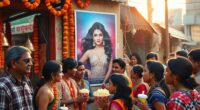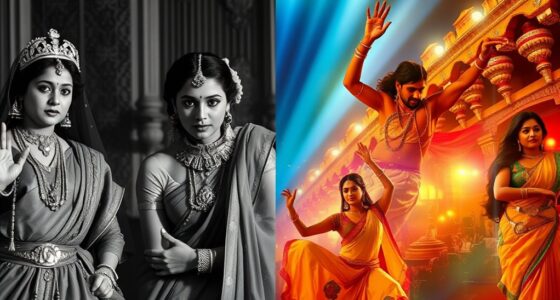The rise of South Indian stars in Bollywood is reshaping the film industry. Iconic actors like Dhanush and Rajinikanth are bridging gaps between regional and mainstream cinema, bringing unique storytelling techniques to wider audiences. Collaborations like *2.0* and new projects with popular actors signal a trend towards cross-industry partnerships. With their box office success, South Indian films are influencing Bollywood narratives, showcasing a rich cultural exchange. Explore how this evolution is changing the landscape of Indian cinema further.
Key Takeaways
- South Indian stars like Dhanush and Jr. NTR are gaining recognition in Bollywood, showcasing the appeal of regional talent.
- Collaborations, such as *2.0* with Rajinikanth and Akshay Kumar, highlight cross-industry engagement and success.
- Upcoming projects, including Janhvi Kapoor’s debut in *Devara: Part I*, signify the continued rise of South Indian actors in Bollywood.
- The popularity of South Indian films on OTT platforms has increased visibility for regional stars, attracting Bollywood producers’ attention.
- The blending of storytelling styles in collaborations enriches both industries and fosters cultural appreciation.
The Emergence of South Indian Cinema
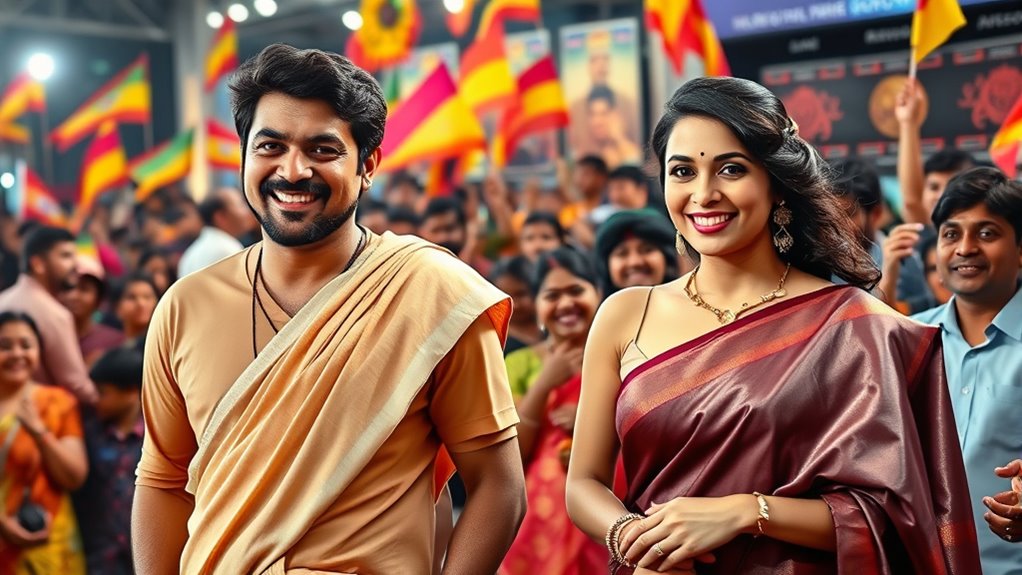
As South Indian cinema began to take shape in the early 20th century, it carved a unique identity that would eventually resonate beyond regional boundaries. You’d notice that the first Tamil silent film, *Keechaka Vadham*, produced in 1918, laid the groundwork for a thriving industry. Tent cinema introduced by Swamikannu Vincent brought films to open areas, making cinema accessible to many. Early studios in Salem and Coimbatore, along with Chennai emerging as a major hub, fueled this growth. Despite technical challenges, foreign films initially influenced local productions. The arrival of talkies in 1931 with *Kalidas* marked a significant turning point, allowing for richer storytelling and character development, further solidifying South Indian cinema’s distinct voice in the cinematic landscape. This evolution set the stage for the first talking motion picture to showcase the artistic potential of regional storytelling.
Notable Collaborations Between South Indian and Bollywood Stars
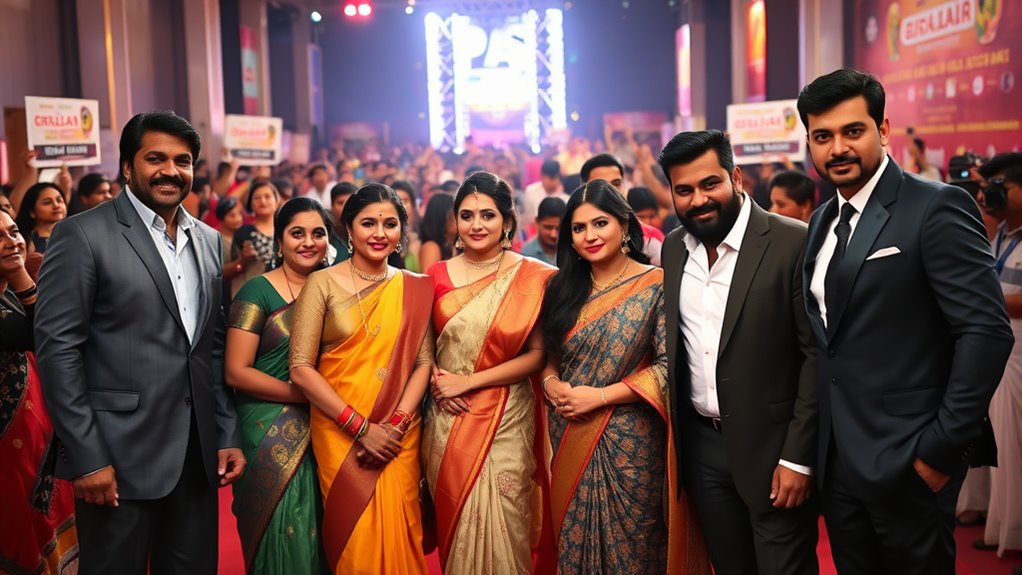
The evolution of South Indian cinema has significantly influenced Bollywood, leading to an increase in collaborations between stars from both industries.
Notable films like *2.0*, featuring Akshay Kumar and Rajinikanth, showcase action and sci-fi elements, while *Raanjhanaa* marked Dhanush’s Bollywood debut alongside Sonam Kapoor, exploring complex love themes. In *Shamitabh*, Amitabh Bachchan and Dhanush unite in a satirical drama about the film industry. Additionally, *Enthiran* is a landmark film that paved the way for high production values and set a benchmark for visual effects in Indian cinema.
Noteworthy collaborations like *2.0* and *Raanjhanaa* highlight the rich storytelling and genre diversity bridging South Indian and Bollywood cinema.
*Saaho* stars Prabhas and Shraddha Kapoor, marking Prabhas’s entry into Bollywood. Finally, *RRR* brings together Jr. NTR, Ram Charan, Alia Bhatt, and Ajay Devgn in a historical epic.
These collaborations not only enhance storytelling but also foster cultural exchange, broadening the audience for both South Indian and Bollywood films.
Box Office Success of South Indian Films

While many might associate box office success with Bollywood, South Indian films have carved out a remarkable niche, shattering records on both national and international stages.
Films like Baahubali 2 and Pushpa 2 have grossed an astonishing 1810 Crore and 1604 Crore, respectively. RRR and KGF 2 also made waves, earning 1236 Crore and 1235.2 Crore, showcasing their widespread appeal. In 2023, the release of Kalki 2898 further exemplified this trend, amassing a box office collection of 938.1 Crore and drawing attention for its science fiction action narrative.
This success isn’t just local; South Indian films have captured global audiences, particularly in the US and Middle East, thanks to compelling stories and high production values.
Technological advancements, including innovative cinematography, have further enhanced the viewing experience, making these films competitive with Hollywood.
Clearly, the rise of South Indian cinema marks a significant transformation in the global film landscape.
Impact of South Indian Films on Bollywood Storytelling
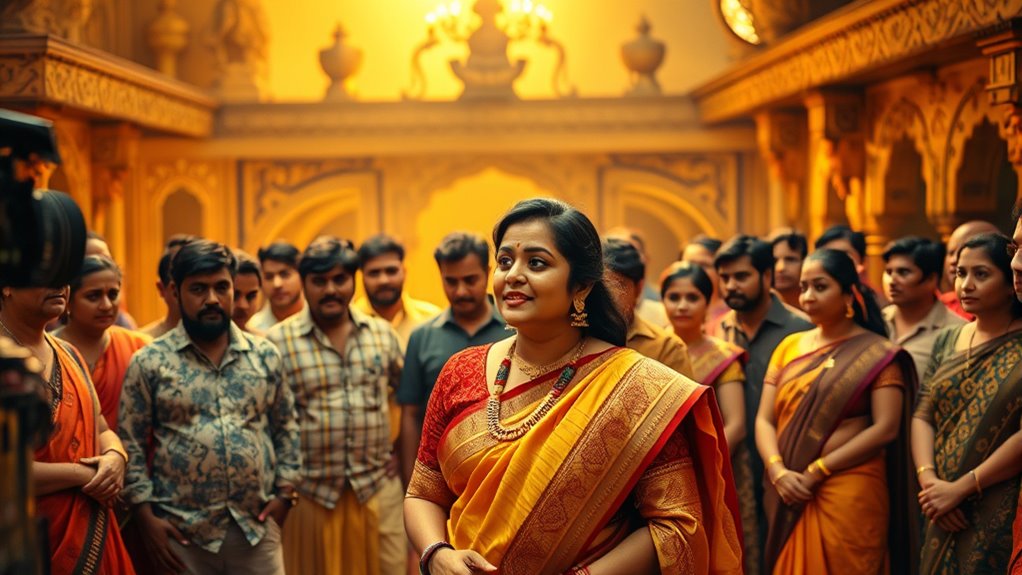
A noticeable shift in Bollywood storytelling has emerged, driven by the influence of South Indian films. You’ll notice that cultural authenticity and diverse narratives are now shaping Bollywood scripts, appealing to broader audiences. The incorporation of regional roots enriches the storytelling, making it more relatable. With high production values and thrilling action sequences, South Indian cinema has raised the bar for Bollywood’s narrative style. While some films risk homogenization by mimicking these tropes, cross-pollination between filmmakers fosters innovation. You’ll see Bollywood adapting regional elements, enhancing its cultural identity while embracing new themes. This evolution reflects changing audience preferences, as viewers crave more action-packed and culturally sensitive stories that resonate on both local and global levels. Furthermore, the increasing presence of Southern talent in Hindi cinema is contributing to this narrative shift.
South Indian Actors Making Their Mark in Bollywood
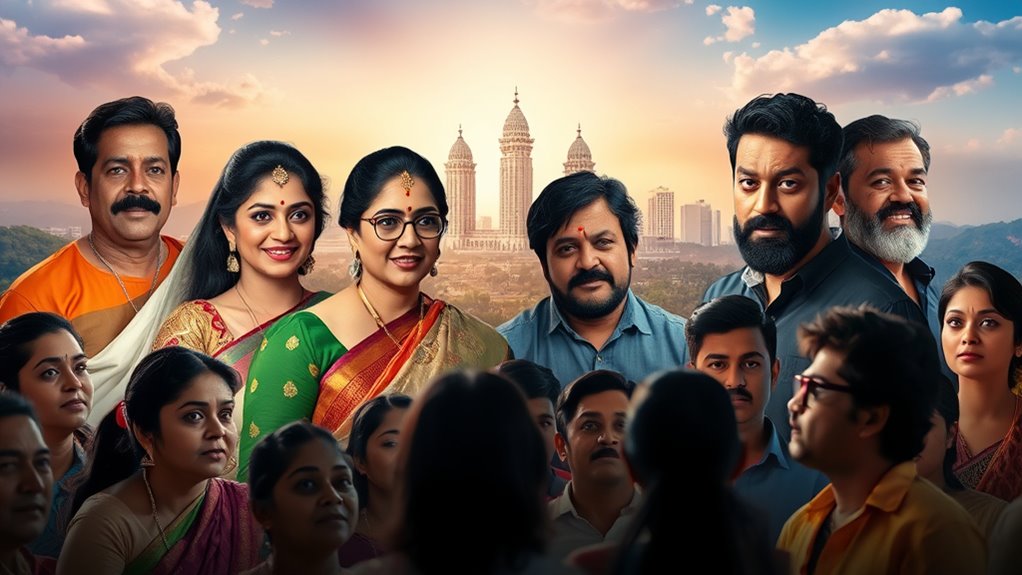
Emerging from the growing influence of South Indian storytelling in Bollywood, actors from the South are making significant strides in the Hindi film industry.
The rise of pan-India films has helped stars like Prabhas and Jr NTR gain recognition nationwide. With cross-industry collaborations, it’s easier than ever for these actors to transition into Bollywood. Notably, Prabhas is known as the First Pan-Indian Superstar, showcasing the impact of South Indian actors on a broader scale.
Global recognition of South Indian films resonates with audiences, allowing talents like Nayanthara and Naga Chaitanya to explore new opportunities. Reduced language barriers and cultural storytelling enhance their appeal, while effective promotional strategies boost visibility.
Despite facing challenges like market competition and cultural differences, South Indian actors are carving out a space in Bollywood, paving the way for a more inclusive film landscape.
The Influence of OTT Platforms on South Indian Cinema
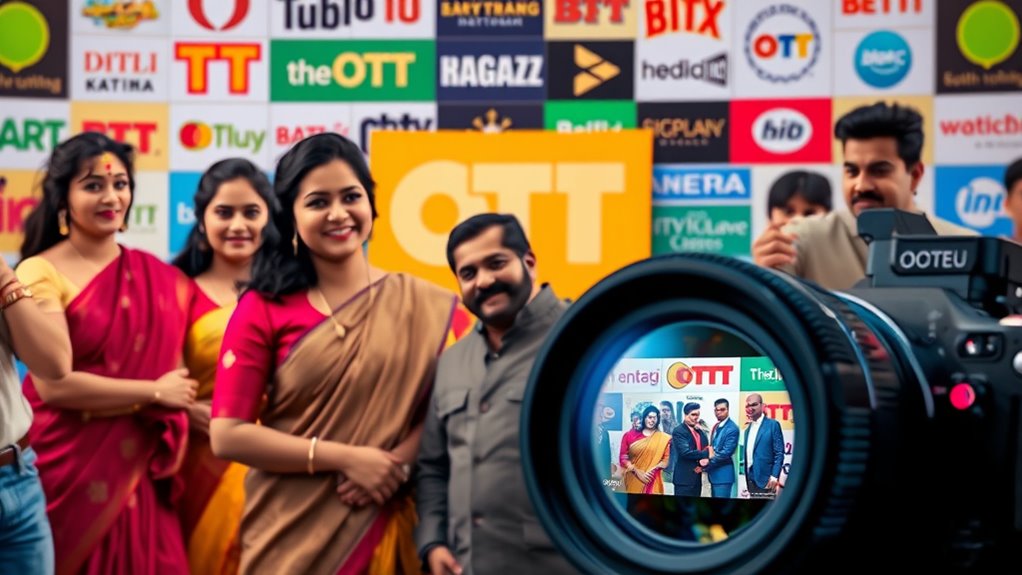
As the digital landscape evolves, OTT platforms have become vital for South Indian cinema, reshaping how audiences consume films and series.
While major platforms often neglect regional content, state-run services like CSpace and dedicated platforms like Aha are emerging, offering a level playing field. These platforms have increased accessibility, allowing global audiences to discover films like “Minnal Murali” and “Soorarai Pottru.” Additionally, regional content has gained traction as filmmakers explore innovative promotion strategies to reach wider audiences. The rise of digital revolutions has further enhanced the visibility of diverse narratives from South Indian cinema.
Emerging platforms like CSpace and Aha are leveling the playing field, making regional cinema accessible to global audiences.
The pandemic accelerated this trend, pushing viewers towards OTT. Language support and diverse content cater to broader audiences, while new talent finds opportunities to shine.
However, challenges remain, such as limited visibility for smaller films and competition with big-budget projects.
Still, regional OTTs are essential for preserving cultural heritage and promoting unique storytelling.
Cultural Exchange Between South Indian and Bollywood Industries
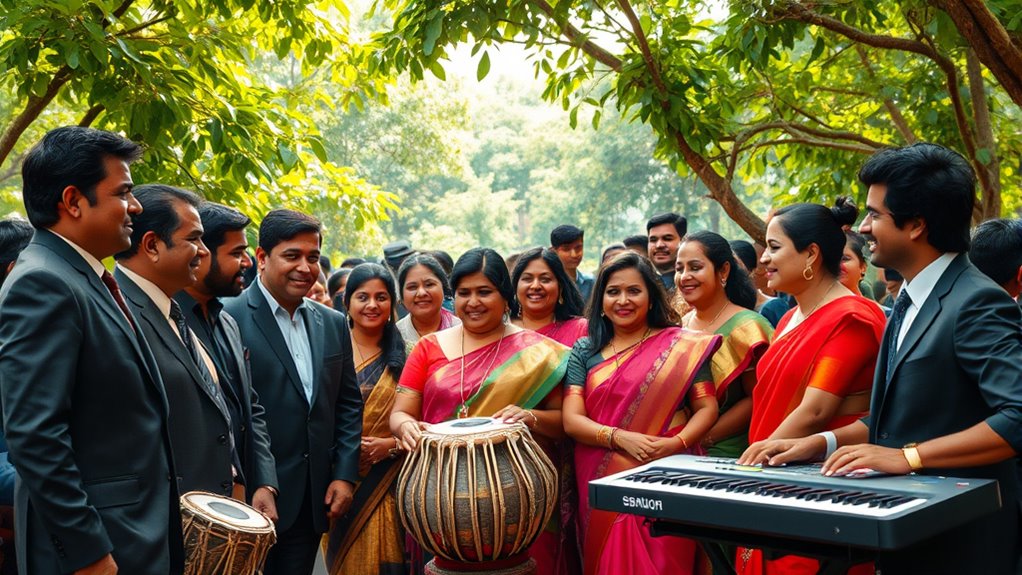
While the lines between South Indian and Bollywood cinema continue to blur, cultural exchange has become a dynamic force shaping the Indian film industry. You’ll notice more South Indian actors gracing Bollywood screens, enriching the storytelling landscape. This pan-India movement promotes inclusivity, allowing for diverse narratives that resonate with wider audiences. South Indian films, known for their cultural authenticity, influence Bollywood’s approach to storytelling, pushing it to innovate. You also see Bollywood’s historical impact on South Indian culture, albeit sometimes through appropriation. With the global success of films like ‘RRR’ and ‘KGF,’ regional narratives gain recognition, fostering deeper cultural appreciation. This exchange also reflects how Bollywood actors and actresses set popular fashion trends, influencing styles across different regions.
Future Trends in South Indian-Bollywood Collaborations
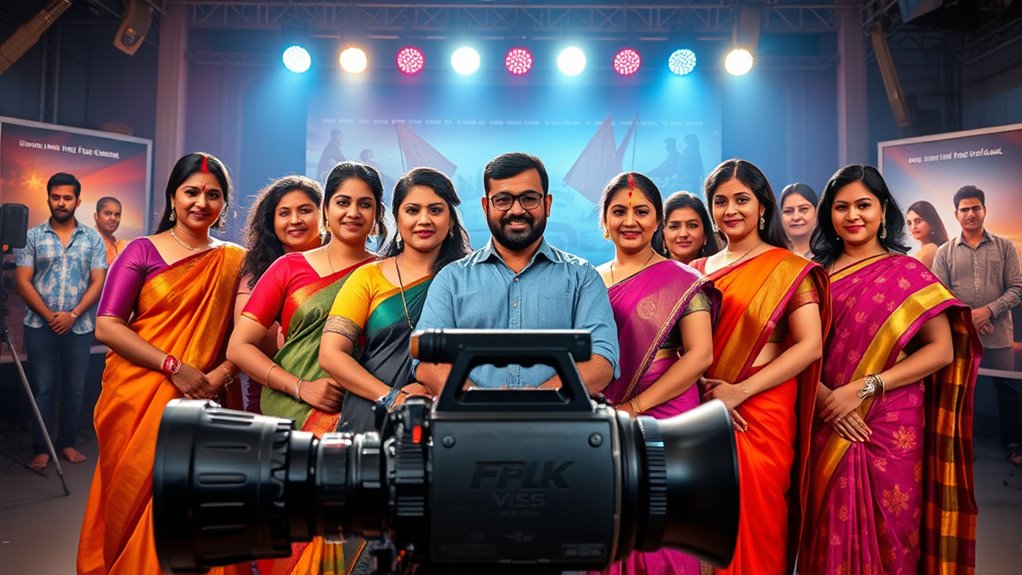
Given the evolving landscape of Indian cinema, you can expect an exciting wave of collaborations between South Indian and Bollywood filmmakers in the near future.
Upcoming projects like Janhvi Kapoor’s debut in “Devara: Part I” alongside Jr. NTR showcase this trend. Saif Ali Khan’s role as an antagonist in the same film further highlights cross-industry casting. Additionally, the southern film industries have a history of serving as a talent pool for Bollywood, which contributes to this ongoing collaboration.
Emraan Hashmi’s partnership with Pawan Kalyan in “OG” signals a growing interest in action-thrillers. Additionally, films featuring stars like Prithviraj Sukumaran and Ranveer Singh promise to blend diverse storytelling styles.
As these collaborations gain traction, they’ll not only enhance box office success but also innovate Indian cinema, appealing to pan-Indian audiences and celebrating cultural diversity.
The Global Reach of South Indian Films
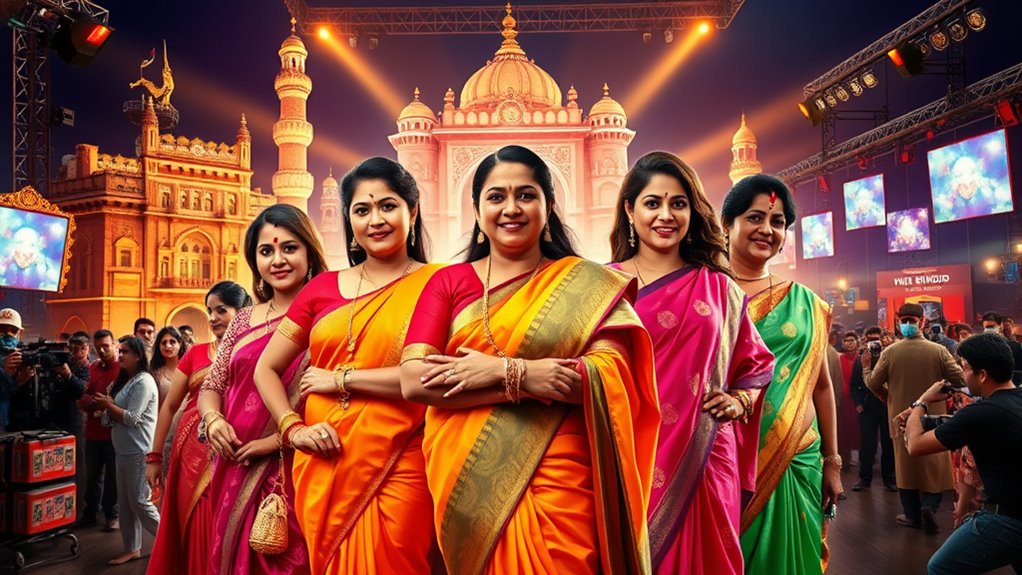
The collaborations between South Indian and Bollywood filmmakers are just a glimpse of the broader phenomenon where South Indian films are making significant strides on the global stage. Their unique storylines and cultural authenticity resonate with diverse audiences, attracting viewers seeking fresh experiences. Films like ‘Baahubali 2’ and ‘RRR’ have shattered box office records, performing exceptionally well in overseas markets, thanks to the large South Asian diaspora. These movies not only garner national recognition but also receive international acclaim, winning prestigious awards and showcasing Indian culture globally. With high production values and innovative genres, South Indian cinema is setting new benchmarks, enhancing its global reach through effective marketing and expanding distribution networks. This success is evidenced by 20 South Indian films receiving awards at the 70th National Film Awards, highlighting the industry’s quality and recognition.
The Evolution of Audience Preferences in Indian Cinema

As technology evolves and new storytelling styles emerge, audience preferences in Indian cinema are shifting dramatically.
You’re increasingly drawn to immersive experiences that enhance your viewing pleasure, thanks to advancements in cinema technology and streaming platforms.
You appreciate the originality and diverse storytelling found in South Indian films, especially as they resonate more with your cultural values compared to traditional Bollywood offerings.
The rise of regional cinema has expanded your options, allowing you to explore engaging narratives that reflect varied cultural backgrounds. Additionally, with the Indian cinema market projected to reach US$5.01bn by 2025, there is a growing investment in innovative storytelling.
Social media keeps you connected to fresh content, making it easier to discover films that speak to you.
Ultimately, you’re prioritizing storytelling quality over star power, shaping the future of Indian cinema.
Frequently Asked Questions
How Do South Indian Films Differ From Bollywood Films?
South Indian films differ from Bollywood films in several key ways.
You’ll notice that South Indian cinema often focuses on local stories and cultural authenticity, whereas Bollywood leans toward broader, sometimes Western-influenced themes.
The storytelling style in South films features traditional hero-villain narratives, while Bollywood often experiments with varied plots.
Additionally, production values and marketing strategies in South cinema have significantly improved, allowing for global recognition and a wider audience reach.
What Challenges Do South Indian Actors Face in Bollywood?
South Indian stars stumble upon significant struggles in Bollywood.
You’ll notice language barriers that hinder heartfelt performances, and stereotypical roles can stifle your versatility.
Cultural clashes complicate connections with audiences, while industry biases block recognition.
Limited roles might leave you feeling frustrated, and building a fanbase can be a formidable feat.
Plus, adapting to the fast-paced, competitive environment adds extra pressure.
Embracing these challenges is crucial for carving your niche in this vibrant industry.
Are There Language Barriers for South Indian Actors in Bollywood?
Yes, there are language barriers for South Indian actors in Bollywood.
You might find that Hindi is the dominant language, making communication with directors and co-stars challenging. This can limit your opportunities and lead to typecasting.
While some actors undergo language training to improve their Hindi, the cultural differences can still impact how you’re perceived.
However, collaborations and pan-Indian films are helping bridge these gaps and enhance recognition for South Indian talent.
How Do South Indian Films Portray Regional Culture?
Oh sure, you thought all films are just about car chases and romance, right?
South Indian films, however, dive deep into regional culture like a seasoned chef into a bowl of spicy sambar. They highlight local folklore, dialects, and social issues, making you feel like you’re right in the heart of South India.
With a mix of authentic traditions and diverse genres, these films connect emotionally, proving there’s more to cinema than just glitz and glamour.
What Role Do Music and Dance Play in South Indian Cinema?
In South Indian cinema, music and dance aren’t just entertainment; they’re vital storytelling tools. You’ll notice how they express emotions and themes, enhancing the narrative.
These elements blend traditional and modern styles, reflecting regional culture while engaging audiences. Moreover, they maintain cultural authenticity, making films relatable to both local and global viewers.
Ultimately, music and dance contribute significantly to the box office success and international recognition of South Indian films.
Conclusion
So, there you have it! South Indian stars are storming Bollywood like they’re auditioning for a superhero role. Who knew that a little masala could spice up the otherwise bland mainstream? As studios scramble to cash in on this trend, you might want to brush up on your Tamil and Telugu. After all, who wouldn’t want to witness a blockbuster where the hero saves the day with a dance-off and a side of curry?

